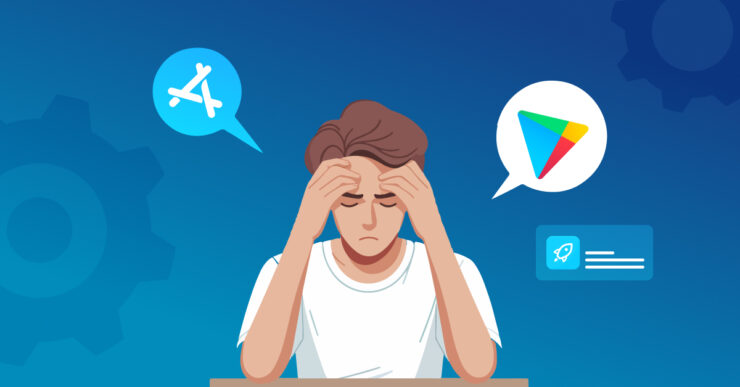The App Store and Google Play are today’s leading platforms for mobile app marketing. It’s critical for developers and publishers to carefully plan their promotional strategies on these platforms to avoid common pitfalls at the outset. The process of enhancing an app’s visibility in app stores is known as App Store Optimization (ASO).
In this article, we will explore the five most common mistakes made by specialists in optimizing app pages on the App Store and Google Play.
ASO vs. SEO: Understanding the Key Differences
There’s a common misconception that App Store Optimization (ASO) is merely Search Engine Optimization (SEO) for mobile apps. This view is mistaken and can be costly for marketing professionals, especially those focusing solely on keyword optimization and search promotion. In reality, ASO encompasses a broader range: it’s a comprehensive optimization of metadata, visual elements, and the app’s context.
Keywords and well-crafted descriptions undoubtedly play a crucial role, but ASO also involves managing categories and sections that shape users’ perception of the app. Examples include “App of the Day,” “Editor’s Choice,” and “Top Categories.” User interaction with the app, such as reviews and ratings, significantly affects the app’s store ranking. All these aspects together form the essence of ASO optimization.
To ensure your mobile app or game becomes popular, it’s critical to capture the attention of as wide an audience as possible. Making your app’s page as attractive and interesting to potential users is key to success. The more users download your app, the more ratings and reviews you’ll receive, which in turn, helps to improve your ranking. A high ranking increases the chances of your app being noticed and featured by app store editors.
Focus on creating engaging and appealing content on your app’s page: vivid images, eye-catching screenshots, and a compelling, comprehensive description of the app’s functionality. These elements are crucial in attracting and retaining the attention of potential users. Remember, your goal is not just to interest users but also to motivate them to download and actively use your app.
How Often Should ASO Optimization Be Performed?
Developers and ASO (App Store Optimization) specialists frequently question the frequency of necessary optimizations. When should ASO begin, and when does optimization end? In reality, the ASO process never truly stops.
Take keywords, for example: after selecting the most relevant keywords, there may arise a need to revisit them due to seasonal changes, emergence of new popular queries, shifts in the competitive landscape, user preferences, and other dynamic market aspects. What’s relevant today may become obsolete tomorrow, making continuous monitoring and adaptation key to a successful ASO strategy.
However, ASO isn’t limited to keywords alone. Elements such as app screenshots, icons, user reviews, and other important factors also require regular optimization and updates. This means your optimization efforts must be ongoing and adaptable to changing market conditions and user preferences.
Therefore, the best answer to the frequency of ASO is constant vigilance and readiness to adapt. Regularly analyze the effectiveness of used keywords, the aesthetics and appeal of visual elements, as well as user reviews and ratings. Changes in these areas may necessitate adjustments to your ASO strategy, ensuring your app remains competitive and appealing to your target audience.
Key Differences Between the App Store and Google Play and Realistic Expectations from ASO
The App Store and Google Play stand as the two main platforms for hosting mobile applications. Although they may seem similar at first glance, their algorithms and approaches to app ranking differ significantly.
Features of App Store and Google Play:
- Google Play leverages Google’s search technologies, facilitating the indexing and searchability of apps through keywords in descriptions. This makes search optimization particularly crucial on Google Play. We recently wrote an article about how ranking works on Google Play, which you can read.
- App Store, unlike Google Play, does not rely as heavily on search technologies due to Apple’s infrastructure characteristics. Here, greater emphasis is placed on user experience and app ratings, impacting their ranking.
Realistic Expectations from ASO:
- ASO is a long-term process requiring a deep understanding of your niche, competitor analysis, and constant optimization. High installation and conversion rates are the results of efforts that may take time to manifest visibly.
- Do not expect instant results from ASO. The process of indexing changes can take more than a week, and for new products, even a month.
- ASO should be part of a comprehensive promotion strategy that also includes search advertising, social media targeting, media advertising, and other channels. In a highly competitive environment, it’s necessary to utilize all available tools to attract potential audiences.
Thus, developers and marketers must understand and consider the differences between the App Store and Google Play when developing an ASO strategy. They should also be realistic in their expectations and ready for a comprehensive approach to promoting mobile applications.
Setting the Right Priorities in ASO
As App Store Optimization (ASO) becomes a more complex and strategic task, choosing the right priorities is key to success for marketers. Here’s how you can systematize your approach to ASO:
Focus on App Quality:
First and foremost, ensure your mobile app or game meets high standards of quality, usability, and relevance. This fundamental aspect is crucial, as all other ASO efforts hinge on the inherent value of your app.
Understanding Your Target Audience:
Next, it’s important to thoroughly understand your target audience. Conduct beta testing, organize pre-registration, and segment users to grasp their preferences and needs fully.
Developing a Comprehensive Promotion Strategy:
With this knowledge, you can move on to developing an overarching promotion strategy. This includes creating a semantic core for optimizing metadata such as the app’s name, subtitle, short and full descriptions, and keywords.
Preparing Visual Elements:
Visual elements play a critical role in attracting attention to your app. Prepare appealing icons, screenshots, and videos that accurately convey the essence and benefits of your application.
Managing Communication:
Finally, after launching the app, it’s crucial to pay attention to reviews, ratings, and the overall ranking. These contextual elements significantly impact potential users’ perception of your app and its ranking in search results.
Remember, ASO is not a one-time task but a continuous process of analysis, testing, and optimization. Regularly updating your ASO strategy in response to changing market conditions and user preferences will help your app stay competitive and in demand.






















